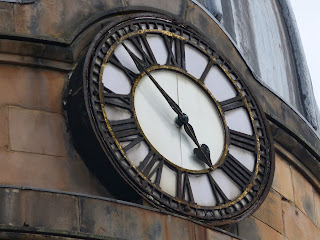Let's move south of Newcastle to Sunderland, from the River Tyne to the River Wear. Crossing the bridge from the north, the first clock we encounter is on a building on the corner of Bridge Street and High Street West.
The clock tower sits proudly over the closed sweet shop called Sweet Home Alabama (or actually make that sits somewhat embarrassed over).
Joplings is at the corner of John Street and St Thomas Street. The building was purpose built as a department store in 1956 after the original one burnt down two years earlier. Sadly the store (which had the first escalator in Sunderland) ceased trading in June 2010.
I love this clock - it is a very simple design that works well for its size and location.
The next two pictures are of clocks seen from a distance from a footbridge over the A1018 - apologies that I didn't have time to go and explore them close up.
The photo above is of the Church of Holy Trinity in Church Street East, opened in 1719 and closed for worship in 1988. The clock itself was added in 1856.
The photo below is of the Quayside Exchange on Wylam Wharf, a Grade II listed building dating from 1814.
Back to the town centre (or city centre I should say). Another modern design, this time on an empty office building next to the Post Office on Fawcett Street.
The building is up for sale by Sunderland City Council, so I assume that it was originally some form of civic building. Part of the ground floor is occupied by a record shop (Pop Recs Ltd).
We move on to Waterloo place outside of the railway station, and to this example above a betting shop.
The clock is somewhat worse for wear, although the second face around the corner is in much better (no pun intended) condition.
Not much to say about this next one. A small clock mounted above the manager's office in the Park Lane Interchange.
Next door is the West Park United Reform Church on Stockton Road, a Grade II listed building of 1883.
This splendid building in Green Street was once the technical college, but is now sadly a collection of various eateries and clubs. It is named the Galen Building and completed in 1901. It was built under powers granted to local authorities by the Local Taxation (Custom and Excise) Act of 1890 to draw central funds for technical education.
The face is damaged, although is intact on the other side. Unusually for a clock of this type, the numerals used are Arabic rather than Roman.
Next stop is Sunderland Minster, renamed in 1998 after Sunderland was granted city status six years earlier.
Opposite is the marvellous building that is the Dun Cow pub. The whole design is lovely, but the roof line is particularly splendid.
A quick quiz question - what on earth is this archway? I have to assume that this belongs to an earlier building on the site, and was retained in situ when the modern office block was constructed. it is rather incongruous, but somehow seems to work.
Next door is the Magistrates Court.
This is a shot down High Street West, showing the Rotary clock, the M&S timepiece (see below for both of these) and in the distance the Bridge Street clock that we started with.
This cuboid clock marks the golden jubilee of the Sunderland Rotary Club (1922 - 1972)
And finally, good old M&S. Nothing more to say really.




































No comments:
Post a Comment